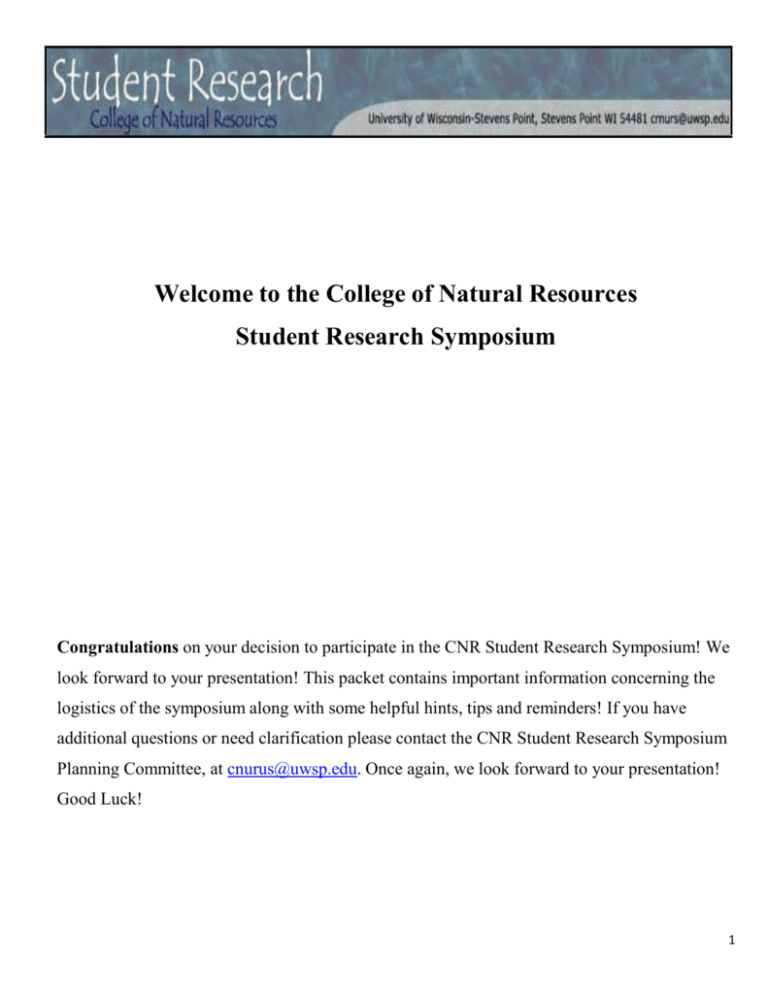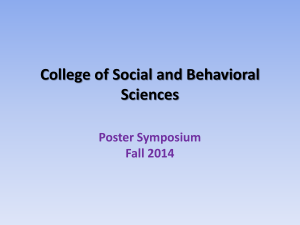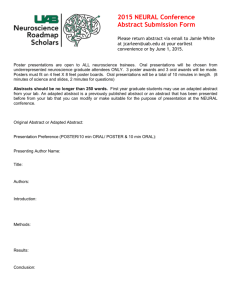Presenters
advertisement

Welcome to the College of Natural Resources Student Research Symposium Congratulations on your decision to participate in the CNR Student Research Symposium! We look forward to your presentation! This packet contains important information concerning the logistics of the symposium along with some helpful hints, tips and reminders! If you have additional questions or need clarification please contact the CNR Student Research Symposium Planning Committee, at cnurus@uwsp.edu. Once again, we look forward to your presentation! Good Luck! 1 Student Research Symposium 2014 Table of Contents Timeline . . . . . . . . . . . . . . . . . . . . . . . . . . . . . . . . . . . . . . . . . . . . 3 Symposium: Before and After . . . . . . . . . . . . . . . . . . . . . . . . . . . 3 Presentation Policies . . . . . . . . . . . . . . . . . . . . . . . . . . . . . . . . . . . 4 Tips for Symposium Success. . . . . . . . . . . . . . . . . . . . . . . . . . . . . 5 Poster Presentation Score Sheet . . . . . . . . . . . . . . . . . . . . . . . . . . . 6 Poster Presentation Critique Guidelines . . . . . . . . . . . . . . . . . . . . 7 Tips for Poster Presentations . . . . . . . . . . . . . . . . . . . . . . . . . . . . . 8 Oral Presentation Score Sheet . . . . . . . . . . . . . . . . . . . . . . . . . . . . 9 Oral Presentation Critique Guidelines . . . . . . . . . . . . . . . . . . . . . 10 Tips for Oral Presentation . . . . . . . . . . . . . . . . . . . . . . . . . . . . 11-13 2 Timeline (see website or poster board for dates) Submission Deadline: February 21 by Midnight Presenter Photo Session: February 27th, 12 noon-2pm Proof Pages Available For Presenters: March 10th, CNR 180 Proof Pages Due: March 12, 4PM CNR 180 Booklet Sent to Print: March 14 CNR Student Research Symposium: April 4th Symposium: Before and After Before For oral presenters, practice using visual aids and staying within the time constraints. Prior to the Symposium, rooms will be available for presenters to practice and become familiar with the surroundings and technical equipment. For poster presentations, practice is still important. It is more important for poster presenters to anticipate what kind of questions may be asked. Poster presentations should be hung in their designated position in advance of the symposium, typically the night before. Try to print poster early to avoid problems. Symposium On the day of symposium, check in at the information table, and receive your nametag and Symposium Program Booklet. If you are giving an oral presentation, make sure that the room is in order before the presentation and check in with the moderator. For a poster presentation, make sure that all your materials are ready and you are at your poster at the appointed times. Be alert to any last minute changes! After Relax! All your hard work has been accomplished. Stand back and appreciate all your efforts and realize that you did the best possible job and you learned a lot along the way. Evaluation forms will be tabulated following the symposium. Highest honors will be announced and distributed at the CNR banquet, the night of the Symposium. 3 Presentation Policies All Symposium presentations will be critiqued by three or more evaluators composed of current or retired faculty/staff, graduate students, and other professionals. Please adhere to the following policies of presentations for ease of evaluation and consistency. Oral Presentations Oral presentations will occur throughout the day of the symposium. Check your presenter schedule for your presentation time and room location. All presentations are limited to 15 minutes, with up to 5 minutes for questions. TNR 170 will be available for short presentation rehearsals the evening before symposium, concurrent with poster hanging times (4-7 pm). Visit the Registration Area the day of Symposium for your name badge and program booklet. Check in with the moderator BEFORE the beginning of the oral presentation session. PowerPoint Presentations ALL PowerPoint presentations need to be burned on a CD or Flash drive. (CD burners available in all computer labs on campus, for assistance contact a committee member at cnrurs@uwsp.edu) Work with a mentor to proof your presentation before turning it in. Presentations burned on a CD should be brought to TNR 170 and uploaded to the computer the evening before the symposium during poster hanging, Thursday, April 3rd between 4-7pm. Poster Presentations All poster presentations will be displayed on the walls of the TNR building on the 1st floor, and need to be hung the evening before the symposium (April 3rd 4-7 pm). Posters cannot exceed the 36 X 54 inch size limit (also the maximum that the TNR plotter can print.) For assistance printing a poster contact the committee, cnrurs@uwsp.edu) Please print any finished poster ahead of time to reduce the crowding at the printer the night before the symposium. DO NOT wait until the last day to finish your poster. BEFORE you hang your poster, please visit the registration area to see a committee member for assistance; the presenter’s location will be assigned, by number, the evening before the symposium. ALL posters need to be hung with wall-safe tape which will be provided. 4 Tips for Symposium Success! Presenters: • Dress appropriately • Be on time • Prepare answers to common interview questions in advance • Be enthusiastic • Present a confident self-image • Listen actively and be engaged in the conversation • Listen attentively and show interest when questioned • Focus on the research • Show courtesy and politeness • Give honest answers Questions you may be asked during the Symposium: What is the purpose of the research? How long has the project been going? How many hours did you work on this project? Where was your data collected? What was your motivation to conduct this research? What future plans do you have for this project? What problems did you encounter? How did you overcome these problems? How could what you learned be useful to others? What would you do differently if you could do the research again? What other research has been done on this topic? Were any on-campus organizations involved in the research? 5 Oral Presentation Score Sheet Name of presenter: _____________________________________________________________________________ Directions: Rate the presentation on each of the 10 criteria below. Points value range from 0-20 for each category. Please do not assign points that fall between the rating intervals. Use the questions on the back of this form to develop your assessment. Also bear in mind that the scoring scale does not directly correspond with a traditional grading scale. We would like to stress the importance of written feedback, please use the space provided below. For projects that a study design or methods is not applicable, please indicate so. Key: Unacceptable Average 0 Criteria Not Applicable 5 Exceptional 10 Index Score 15 20 Comments Statement of problem and justification Study design and methods Data analysis and interpretation Discussion & Conclusion Response to questions Presentation organization and coherence Overall technical competence Speaking style Use of visual aids Professional attire & appearance Score Total: Additional Comments: Judge’s Name: _____________________________________________________________________________________ 6 Oral Presentation Critique Guidelines Statement of Problem and Justification How well did the speaker describe the area of speaker interest? Was there a well-conceived rationale for undertaking the study? Were hypotheses or study objectives clearly communicated and appropriately developed? Study Design and Methods Was the study design appropriate given the study hypotheses or objectives? Were data collection methods valid and reliable? Did the speaker acknowledge assumptions or limitations of the methods? Data Analysis and Interpretation Were appropriate statistical or analytical procedures used? Was the interpretation logically derived from the data presented? Discussion & Conclusion Did the discussion tie results back to study objectives/ hypotheses? Did the conclusion drawn flow from the data presented? Did the speaker present the implications of the study for management and/or future research? Response to Questions Did the speaker provide direct and professional responses to audience questions? Was the speaker poised and confident or flustered and defensive? Presentation Organization and Coherence Was the presentation easy to follow and understand? Was there a beginning, middle, and an end? Were there smooth transitions between sections? Overall Technical Competence Did the overall presentation demonstrate a thorough knowledge of subject’s content area? Did the speaker convey a thorough understanding of process and procedures of scientific research? Speaking Style Did the speaker address the audience cordially and professionally? Did the speaker maintain eye contact, use gestures comfortably, and maintain appropriate pace and tone of expression? Use of Visual Aids: Professional Were slides/overheads attractive and visually engaging? Were data graphs/tables clearly labeled and easily deciphered? Were visual aids used to enhance oral communication or were they or distracting? Attire & Appearance Did the speaker’s wardrobe and overall appearance convey a professional and credible tone? 7 Poster Presentation Score Sheet Name of presenter: ___________________________________________________________________________ Directions: Rate the presentation on each of the 10 criteria below. Points value range from 0-20 for each category. Please do not assign points that fall between the rating intervals. Use the questions on the back of this form to develop your assessment. Also bear in mind that the scoring scale does not directly correspond with a traditional grading scale. We would like to stress the importance of written feedback, please use the space provided below. For projects that a study design or methods is not applicable, please indicate so. Key: Unacceptable Average 0 Criteria Not Applicable 5 Exceptional 10 Index Score 15 20 Comments Statement of problem and justification Study design and methods Data Analysis and interpretation Discussion & Conclusion Poster organization and coherence Overall technical competence Overall graphic lay-out and design Quality of visual elements Interaction with judge Professional Attire & Appearance Score Total: Additional Comments: Judge’s Name: _____________________________________________________________________________________ 8 Poster Presentation Critique Guidelines Statement of Problem and Justification How well did the poster describe the nature of the research question or issue? Was there a well-conceived rationale for undertaking the study? Were hypotheses or study objectives clearly communicated and appropriately developed? Study Design and Methods Was the study design appropriate given the study hypotheses or objectives? Were data collection methods valid and reliable? Did the poster acknowledge assumptions or limitations of the methods? Data Analysis and Interpretation Were appropriate statistical or analytical procedures used? Was the interpretation logically derived from the data presented? Discussion & Conclusion Did the discussion tie results back to study objectives/ hypotheses? Did the conclusion drawn flow from the data presented? Did the poster present the implications of the study for management and/or future research? Poster Organization and Coherence Was the poster easy to follow and understand? Was there a beginning, middle, and an end? Were appropriates headings and other transitions provided between sections? Overall Technical Competence Did the overall poster convey a thorough knowledge of the topic content area? Did the poster convey a thorough understanding of process and procedures of scientific research? 9 Overall Graphic Layout and Design Was the color scheme of the poster, including the background, font style and color, and arrangement of elements, attractive and balanced? Did the poster effectively use space without appearing “cluttered”? Quality of Visual Elements (answer all that apply) Were the font style and sizes easy to read? Did the poster effectively incorporate charts, graphs, and pictures with the text material? Were data presented visually in a way that was easily interpreted (i.e. could it stand alone)? Were pictures, charts, maps, etc. presented in sharp images with sufficient resolution? Interaction with Judge Did the poster author(s) seem at ease with the judge and provide direct and professional responses to questions? Were the poster author(s) poised and confident or flustered and defensive? Attire & Appearance Did the poster’s wardrobe and overall appearance convey a professional and credible tone? 10 Tips for Oral Presentations Images Images are the most important components in your presentation. Do: Tell the story through pictures. Use full-screen, high-quality images. Select images that creatively illustrate your talk. Scan at resolution of 80 dpi. Scan horizontal pictures with a width of 11.75” Scan vertical pictures with a height of 9” (crop your pictures if needed). Make your images and talk stand-alone. Graphics should illustrate what you’re saying. Do not: Read directly off slides, any text should be general allowing you to expand on topics. Look at the screen while you are talking. Use graphics from the Internet unless they are high quality. Use small or poor quality images. Overuse Microsoft clipart. This detracts from the professional quality of your presentation. Backgrounds and Transitions The background of your presentation is the color, color blend, pattern, or graphic that you place behind the rest of your elements. Transitions are the visible changes that take place when your slides move from one to another. Backgrounds and transitions subconsciously impact how the audience feels and responds to your program. Backgrounds Do: Use unified backgrounds. Make sure backgrounds are thematic (“fit in” with the theme of your presentation). Keep it simple. Consider the emotional impact backgrounds can have on your audience. Use black backgrounds on full-screen images (majority of your presentation). Use black slides to bring the focus back to the presenter. Do not: Use multiple types of backgrounds, unless they serve a purpose. Use backgrounds that detract from your images (primary focus). Use a colored background behind a full-screen image. 11 Transitions Do: Use unified and thematic transitions. Consider the emotional impact transitions can have on your audience. Do not: Use multiple types of transitions, unless they serve a purpose. Use distracting transitions that take away from your theme. Text Limit the amount of text you use in your presentation. An interpretive presentation is much different than presentations you may have seen in classrooms. Images should be the primary focus of your program. Do: Use text for title slides, headings (transitions), quotes, and captions. Use simple fonts that are easy to read. Use fonts that are large enough to read from the back of the room (24 point minimum). Keep your text unified and thematic. Consider the emotional impact different fonts can have on your audience. Do not: Overuse text. Use text as “notes on the screen.” Use text to display every point in your program. Use multiple types of fonts, unless they serve a purpose. Use “fancy” fonts that are difficult to read, unless they serve a purpose. Use too little or too much contrast between background and text. Animation Animation can be used to control the revelation of connections and intriguing information. Limit the amount of animation you include. The more sparingly you incorporate animation, the more effective the animation you do include will be. Do: Use animation to focus on important points. Use it to control the flow of information. Use it to add interest and surprise to your presentation. Use thematic animation that has a purpose. Use animation sparingly. It will have more of an impact. Do not: Overuse animation to the point of audience sickness. Use animation just because you can. Animation must have a purpose. 12 Sounds and Movies PowerPoint combines many tools into one. Instead of bringing along a slide projector, DVD player, and television, everything can be digitized and saved onto a single computer. Sound and movies add a different dimension to your program, and can create emotional links with the audience. Sounds/Music Do: Use to add another sensory experience for the audience. Helps to involve them. Use to create a mood or unique environment. Sound can transport people to a different place and time. Sounds should be thematic and contribute to interpreting your topic. Make sure the sounds work and the volume is appropriate before your program starts. Do not: Add sounds without a purpose. Whooshes with animated words are usually not appropriate. Be careful playing sounds/music while you’re talking. Check the volume before the program. Movies Do: Use to enhance your program by including motion and sounds. Use moving pictures that are thematic and have a purpose. Do not: Use movies if the quality looks poor. Helpful Hints Know your PowerPoint equipment. Practice with the equipment before your presentation. Copy font, sound/music, and movie files in addition to your presentation file. Make several copies of your presentation. Flash Drive, CD, H: drive, hard drive Stand in front of the audience. Use a wireless presenter that has a mouse function. Involve the audience. Use a variety of interpretive techniques. Practice makes perfect. Practice on different computer. 13 14





